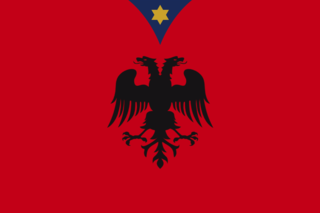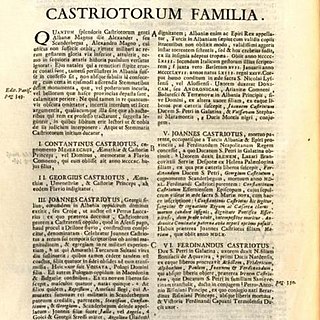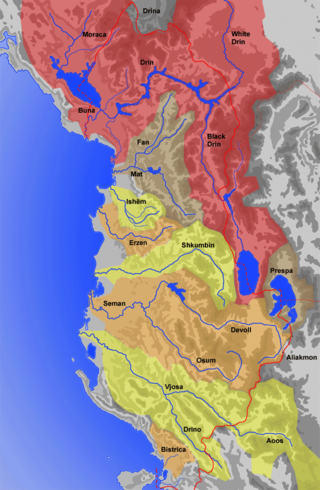Giammaria Biemmi was an Italian priest who published a work on Skanderbeg titled Istoria di Giorgio Castrioto Scanderbeg-Begh. His work was published in Brescia, Italy in 1742. [1]
His work claimed to be derived from sources older than Marin Barleti's, generally considered the main primary source on Skanderbeg. He made use of contemporary Italian humanists and historians who wrote on Skanderbeg such as Francescus Philephus (1389-1481), Johanes Jovianus Pontanus (1423-1503), Raffaele Maffei Volaterranus (1434-1516), while also using two Byzantine chroniclers, Laonikos Chalkokondyles (1423-1464) and George Sphrantzes (1401-1478). He furthermore made use of archival documents compiled by Odorico Raynaldi (1595-1671) and G. Sagredo (1616-1696). [1]
He also claimed that he had found a work published in Venice in 1480 from which he could not find the name of the author, although he was an Albanian humanist from Bar, in modern-day Montenegro. [1] According to this biographer, his brother was a warrior in Skanderbeg's personal guard. According to Biemmi, the work had lost pages dealing with Skanderbeg's youth, the events from 1443-1449, the Siege of Krujë (1467), and Skanderbeg's death. Biemmi referred to the author the work as Antivarino, meaning the man from Bar. [2]
The passages given by Antivarino come out as being more neutral than Barleti's panegyric work. There is no rhetoric and both Skanderbeg's failures and successes are mentioned without leaning towards either side. Using Antivarino as his main work, Biemmi drew harsh criticism against Barleti; however, he criticizes Antivarino on certain points and still agrees with Barleti's major points. [2]
Antivarino
Since Antivarino's work has never been found, polemics over Antivarino's authenticity arose. [2] As a result, most scholars used Barleti's work instead, despite criticisms against it. The first modern historians to use Biemmi were Francesco Tajani and J. E. Pisko, who both regarded Antivarino's work as the earliest one on Skanderbeg. [3] Fan Noli in his first work on Skanderbeg, Historia e Skënderbeut, mbretit të shqiptarëve, holds that Antivarino is an authentic source which Biemmi used. [4] Athanas Gegaj, in his dissertation prepared for the University of Paris, defends Biemmi, saying that he gives us, through Antivarino, valuable information about Albanian society and its princes at the time. [5] [6] Several years later, however, Franz Babinger, in his work dealing with the foundation of Elbasan, asserted that Antivarino never existed. He furthermore stated in Eine Gefälschte Radolt inkunabel that Biemmi aimed to raise interest in his work so he falsified a source. [5] Fan Noli, in his PhD thesis for the University of Boston, George Castroiti Scanderbeg (1405-1468), regards Babinger's conclusions as unconvincing and furthermore argues that the wealth of information could not have been falsified. [7] [8] American historian Kenneth M. Setton states that Noli had not discovered that Biemmi invented the Anonymous of Antivari and that Antvarino was a fraud. He also says that the two "early" chronicles of Brescia were also forged by Biemmi. [9] Noli argues, however, that Luccari, a Ragusan annalist, knew of a History of Scanderbeg by the Archbishop of Durrës who was from Antivari. [10] Rinaldina Russell of Queens College who holds PhD in Italian literature, states that Antivarino's work, provided by Biemmi, is more reliable than Barleti's. [11]

The League of Lezhë, also commonly referred to as the Albanian League, was a military and diplomatic alliance of the Albanian aristocracy, created in the city of Lezhë on March 2, 1444. The League of Lezhë is considered the first unified independent Albanian country in the Medieval age, with Skanderbeg as leader of the regional Albanian chieftains and nobles united against the Ottoman Empire. Skanderbeg was proclaimed "Chief of the League of the Albanian People," while Skanderbeg always signed himself as "DominusAlbaniae".

The siege of Berat took place in July 1455 when the Albanian army of Skanderbeg attempted to capture the fortress in the Albanian city of Berat, which was held by Ottoman forces. The attempt resulted in a failure when an Ottoman relief army arrived and routed the besieging forces.
The fourth siege of Krujë by the Ottoman Empire of Krujë in Albania occurred in 1478, ten years after the death of the Skanderbeg, and resulted in the town's capture after the failure of three prior sieges.

The House of Kastrioti was an Albanian noble family, active in the 14th and 15th centuries as the rulers of the Principality of Kastrioti. At the beginning of the 15th century, the family controlled a territory in the Mat and Dibra regions. The most notable member was Gjergj Kastrioti, better known as Skanderbeg, regarded today as an Albanian hero for leading the resistance against Mehmed the Conqueror's efforts to expand the Ottoman Empire into Albania. After Skanderbeg's death and the fall of the Principality in 1468, the Kastrioti family gave their allegiance to the Kingdom of Naples and were given control over the Duchy of San Pietro in Galatina and the County of Soleto, now in the Province of Lecce, Italy. Ferrante, son of Gjon Kastrioti II, Duke of Galatina and Count of Soleto, is the direct ancestor of all male members of the Kastrioti family today. Today, the family consists of two Italian branches, one in Lecce and the other in Naples. The descendants of the House of Kastrioti in Italy use the family name "Castriota Scanderbeg".

Gjergj Kastrioti, commonly known as Skanderbeg, was an Albanian feudal lord and military commander who led a rebellion against the Ottoman Empire in what is today Albania, North Macedonia, Greece, Kosovo, Montenegro, and Serbia.
The Battle of Torvioll, also known as the Battle of Lower Dibra, was fought on 29 June 1444 on the Plain of Torvioll, in what is modern-day Albania. Gjergj Kastrioti Skanderbeg was an Ottoman Albanian general who decided to go back to his native land and take the reins of a new Albanian League against the Ottoman Empire. He, along with 300 other Albanians fighting at the Battle of Niš, deserted the Ottoman army to head towards Krujë, which fell quickly through a subversion. He then formed the League of Lezhë, a confederation of Albanian princes united in war against the Ottoman Empire. Murad II, realizing the threat, sent one of his most experienced captains, Ali Pasha, to crush the new state with a force of 40,000 men.

Principality of Kastrioti was one of the Albanian principalities during the Late Middle Ages. It was formed by Pal Kastrioti who ruled it until 1407, after which his son, Gjon Kastrioti ruled until his death in 1437 and then ruled by the national hero of Albania, Skanderbeg.

Andronika Arianiti, also known as Donika Kastrioti, was an Albanian noblewoman and the spouse of Albanian leader Skanderbeg. She was the daughter of Gjergj Arianiti, an earlier leader in the ongoing revolt against the Ottomans.

The Albanian–Venetian War of 1447–48 was waged between Venetian and Ottoman forces against the Albanians under George Kastrioti Skanderbeg. The war was the result of a dispute between the Republic and the Dukagjini family over the possession of the Dagnum fortress. Skanderbeg, then ally of the Dukagjini family, moved against several Venetian held towns along the Albanian coastline, in order to pressure the Venetians into restoring Dagnum. In response, the Republic sent a local force to relieve the besieged fortress of Dagnum, and urged the Ottoman Empire to send an expeditionary force into Albania. At that time the Ottomans were already besieging the fortress of Svetigrad, stretching Skanderbeg's efforts thin.

The siege of Svetigrad or Sfetigrad began on 14 May 1448 when an Ottoman army, led by Sultan Murad II, besieged the fortress of Svetigrad. After the many failed Ottoman expeditions into Albania against the League of Lezhë, a confederation of Albanian Principalities created in 1444 and headed by Skanderbeg, Murad II decided to march an army into Skanderbeg's dominions in order to capture the key Albanian fortress of Svetigrad. The fortress lay on an important route between present-day North Macedonia and Albania, and thus its occupation would give the Ottomans easy access into Albania. The force prepared by Murad was the largest force with which the Ottomans had ever attacked Skanderbeg. Murad planned to take the fortress, march into the Albanian interior, and capture the main citadel of Krujë, thus crushing the Albanian League.

Vrana, historically known as Vrana Konti was an Albanian military leader who was distinguished in the Albanian-Turkish Wars as one of the commanders of Gjergj Kastrioti Skanderbeg, of whom he was one of the closest councillors. He probably belonged to the class of small lords who were tied to the Kastrioti family and possibly belonged to a common lineage (fis) with them. In his youth, he fought as a mercenary in the armies of Alfonso the Magnanimous. The term conte ("count") with which he became known in historical accounts didn't refer to an actual title he held, but to his status as a figure of importance.
Vladan Gjurica was an Albanian nobleman and Skanderbeg's main advisor during Skanderbeg's rebellion. He is thought to be from Gjoricë, in modern-day Dibër County from which he got the surname Gjurica/Jurica. He was most likely a member of the Arianiti family. During the Battle of Vaikal he was captured and sent to Constantinople where he was skinned alive.
The Treaty of Gaeta was a political treaty signed in Gaeta on March 26, 1451, between Alfonso V for the Kingdom of Naples and Stefan, Bishop of Krujë, and Nikollë de Berguçi, ambassadors of Skanderbeg. In the treaty Skanderbeg recognized himself a vassal of the Kingdom of Naples, and in return he would have the Kingdom's protection from the Ottoman Empire. Alfonso V believed that he would be able to resurrect the politics of his Angevine predecessors and to use Albania as a foothold to further expand his realm into the Balkans.

Kostandin Kastrioti Mazreku was an Albanian regional ruler in parts of the wider Mat and Dibër areas. He is the first Kastrioti to be known by his full name and the progenitor of all members of the family. His son was Pal Kastrioti, grandfather of the Albanian national hero, Skanderbeg.

The Plain of Torvioll, or the Plain of Shumbat as it is known today, is located in the Lower Dibra region in eastern Albania, north of Peshkopi. It is most famous for being the battlefield for Skanderbeg's first battle against the Ottoman Empire in the Battle of Torvioll which took place on 29 June 1444. According to a defter gathered by the Ottomans in 1467, the region of Lower Dibra included the northern half of Dibran territory.

Skanderbeg has been the subject of many works of art and literature and the inspiration for countless others. It is a motif in the visual arts, the performing arts, poetry, prose and music.

Pal or Gjergj Kastrioti was an Albanian medieval ruler in the latter part of the 14th century in northern Albania. Not much is known about his life. He is mentioned in only two historical sources which describe his rule as extending in a region between Mat and Dibër. His son was Gjon Kastrioti and his grandson Skanderbeg, the Albanian national hero.

Skanderbeg's rebellion was an almost 25-year long anti-Ottoman rebellion led by the renegade Ottoman sanjakbey Skanderbeg in the territory which belonged to the Ottoman sanjaks of Albania, Dibra and Ohrid. The rebellion was the result of initial Christian victories in the Crusade of Varna in 1443. After Ottoman defeat in the Battle of Niš, Skanderbeg, then sanjakbey of the Sanjak of Debar, mistakenly believed that Christians would succeed in pushing the Ottomans out of Europe. Like many other regional Ottoman officials, he deserted the Ottoman army to raise rebellion in his sanjak of Dibra and the surrounding region. Initially, his plan was successful and soon large parts of the Sanjak of Dibra and north-east parts of the Sanjak of Albania were captured by the rebels who also fought against regular Ottoman forces in the Sanjak of Ohrid.
Stanisha Kastrioti was an Albanian nobleman, a member of the Kastrioti family, and older brother of Skanderbeg.
The Kosovo Raid of 1448, was a military campaign launched by Albanian commander Gjergj Kastrioti Skanderbeg against the Despotate of Serbia. The Raid was a response to Đurađ Branković, who had prevented him to join the Army of John Hunyadi, who was leading a Crusade against the Ottomans, and had clashed with Murad II on the Kosovo field. However, Brankovic's exact role is disputed.












